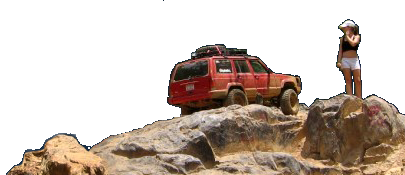- Joined
- Mar 20, 2005
- Location
- Hendersonville, NC
Looking for some feedback from some of the more learned, book smart, ahem nerds on here.
Recently performed a pretty major overhaul on @thebrotherinlaw's XJ. Part of the rebuild was correcting the front driveline angle. Previously, the Dana 300 transfer case was clocked flat, which resulted in a super steep front driveline angle. It was clocked flat using a standard 7/8" thick clocking ring.
To get a better angle, I clocked it down quite a bit. In doing so, the holes that gave the best driveline angle was the ones intended to bolt the ring to the case. The threaded holes on either side of the retaining hole made the angles either too high or too low.
So I simply slid the clocking ring over the new longer studs my BIL picked up, bolted it up and rocked out.
This happened 2 wheeling trips later.

The studs he picked up were not graded appropriately. They weren't even a grade 5. Notice no shoulder and the internal color of the stud looks to me like they aren't intended for use in this application.
So, I picked up some Grade 8 shouldered studs, 3" long (FWIW) replaced the broken ones and all seems to be fine. But I am wanting opinions on WHY the studs broke. Crap studs or because the ring isn't bolted to the case and has created a stress point.
Seeing the studs broken flush with the case makes me wonder if the ring MUST be bolted to the base and then studs untilized to secure it to the transmission. I can't see that being the case. But I'm no expert. When this happened on the trail, extraction was somewhat easy, but had we been on a trail far away from camp, it would be a bad situation.
Cliffs: Were the orginal studs just garbage and I'm overthinking it.
Do I need to pull the case, AGAIN, and machine the hole that the studs slide through for a nut that will secure it to the case and allow the remaining threads to pass through the transmission.
@Fabrik8 @shawn @jeepinmatt @Mac5005 @anyothernerdswhomayknow
EDIT: I will likely install a support ring on the rear output anyway
Recently performed a pretty major overhaul on @thebrotherinlaw's XJ. Part of the rebuild was correcting the front driveline angle. Previously, the Dana 300 transfer case was clocked flat, which resulted in a super steep front driveline angle. It was clocked flat using a standard 7/8" thick clocking ring.
To get a better angle, I clocked it down quite a bit. In doing so, the holes that gave the best driveline angle was the ones intended to bolt the ring to the case. The threaded holes on either side of the retaining hole made the angles either too high or too low.
So I simply slid the clocking ring over the new longer studs my BIL picked up, bolted it up and rocked out.
This happened 2 wheeling trips later.
The studs he picked up were not graded appropriately. They weren't even a grade 5. Notice no shoulder and the internal color of the stud looks to me like they aren't intended for use in this application.
So, I picked up some Grade 8 shouldered studs, 3" long (FWIW) replaced the broken ones and all seems to be fine. But I am wanting opinions on WHY the studs broke. Crap studs or because the ring isn't bolted to the case and has created a stress point.
Seeing the studs broken flush with the case makes me wonder if the ring MUST be bolted to the base and then studs untilized to secure it to the transmission. I can't see that being the case. But I'm no expert. When this happened on the trail, extraction was somewhat easy, but had we been on a trail far away from camp, it would be a bad situation.
Cliffs: Were the orginal studs just garbage and I'm overthinking it.
Do I need to pull the case, AGAIN, and machine the hole that the studs slide through for a nut that will secure it to the case and allow the remaining threads to pass through the transmission.
@Fabrik8 @shawn @jeepinmatt @Mac5005 @anyothernerdswhomayknow
EDIT: I will likely install a support ring on the rear output anyway
Last edited:

